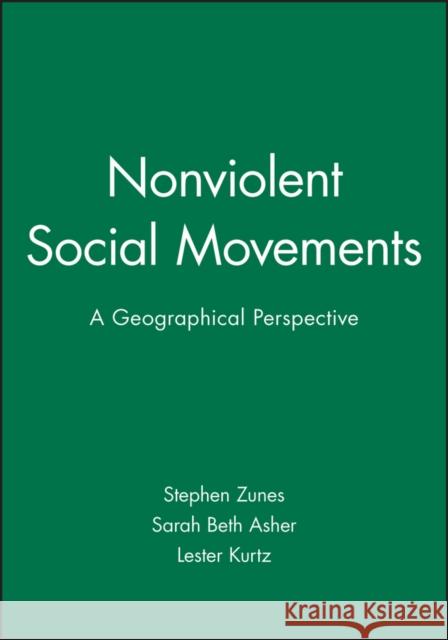Nonviolent Social Movements » książka



Nonviolent Social Movements
ISBN-13: 9781577180760 / Angielski / Miękka / 1999 / 344 str.
Nonviolent Social Movements
ISBN-13: 9781577180760 / Angielski / Miękka / 1999 / 344 str.
(netto: 234,00 VAT: 5%)
Najniższa cena z 30 dni: 243,68
ok. 30 dni roboczych
Bez gwarancji dostawy przed świętami
Darmowa dostawa!
Nonviolent Social Movements is the first book to offer a truly global overview of the dramatic growth of popular nonviolent struggles in recent years.
Wydanie ilustrowane
"At the end of the bloodiest century in human history it is vital that we learn how to solve problems and generate effective social and political change non–violently. This book demonstrates that many brave people in diverse political situations are effective because they have decided that the means are as important as the ends, that one does not defeat evil with more evil, repression with repression, violence with violence. Scholars and activists alike will find much to ponder in this collection. I commend it to everyone with an interest in the future of the human species."
Kevin Clements, George Mason University <!––end––>
"This is an excellent collection of case studies knitted together by the editors′ presentation of a sound set of theoretical issues. Both help us understand the dynamics of nonviolent social movements." Paul Joseph, Tufts University
"A timely book." Pacifica Review
Sources and Acknowledgments.
Notes on Editors and Contributors.
Introduction.
PART I. PERSPECTIVES ON NONVIOLENT MOVEMENTS.
1. Nonviolence and Power in the Twentieth Century (Kenneth E. Boulding).
2. You Can’t Kill the Spirit: Women and Nonviolent Action (Pam McAllister).
PART II. THE MIDDLE EAST.
Introduction.
3. Unarmed Resistance in the Middle East and North Africa (Stephen Zunes).
4. Nonviolent Resistance in the Occupied Territories: A Critical Reevaluation (Souad Dajani).
PART III. EUROPE.
Introduction.
5. The Grassroots Movement in Germany, 1972–1985 (Matthew Lyons).
6. "We Have Bare Hands": Nonviolent Social Movements in the Soviet Bloc (Lee Smithey and Lester R. Kurtz).
PART IV. ASIA.
Introduction.
7. The Origins of People Power in the Philippines (Stephen Zunes).
8. Imagery in the 1992 Nonviolent Uprising in Thailand (Chaiwat Satha–Anand).
9. Violent and Nonviolent Struggle in Burma: Is a Unified Strategy Workable (Michael A. Beer).
PART V. AFRICA.
Introduction.
10. The Ogoni Struggle for Human Rights and a Civil Society in Nigeria (Joshua Cooper).
11. The Role of Nonviolence in the Downfall of Apartheid (Stephen Zunes).
PART VI. LATIN AMERICA.
Introduction.
12. Advocating Nonviolent Direct Action In Latin America: The Antecedents and Emergence of SERPAJ (Ronald Pagnucco and John D. McCarthy).
13. The Brazilian Church–State Crisis of 1980: Effective Nonviolent Action in a Military Dictatorship (Daniel Zirker).
PART VII. NORTH AMERICA.
Introduction.
14. Nonviolent Social Movements in the United States: A Historical Overview (Charles Chatfield).
Conclusion (Stephen Zunes and Lester R. Kurtz).
Index.
Stephen Zunes is an assistant professor of politics and chair of the Peace & Justice Studies Program at the University of San Francisco. His articles have appeared in Middle East Policy, Current History, Arab Studies Quarterly, Third World Quarterly, New Political Science, International Journal, and other scholarly publications. He is an editor of Peace Review and writes and researches extensively in the area of social movements and peace studies.
Lester R. Kurtz is a professor of sociology and Asian studies at the University of Texas, Austin. His research focuses on the analysis of social conflict, the sociology of culture and religion, and global social theory. His other books include Gods in the Global Village: The World′s Religions in Sociological Perspective (1995) and The Web of Violence: From Interpersonal to Global (co–edited with Jennifer Turpin, 1997). He is editor–in–chief of the Encyclopedia of Violence, Peace, and Conflict (1999).
Sarah Beth Asher is an independent researcher and has lived and worked in the Middle East, India, China, and Europe, where she served in the US Army Medical Corps. She has been involved in research on violence as a public health issue.
Nonviolent Social Movements is the first book to offer a truly global overview of the dramatic growth of popular nonviolent struggles in recent years. From the civil rights movement in the United States, and the ′People Power′ movement in the Philippines, to the pro–democracy movements of Asia, Latin America, and Europe, nonviolent action has emerged as a key element of political change in recent decades.
Despite its widespread diffusion as a conscious movement around the world, we still understand little about nonviolence as a technique for social change. This volume seeks to provide an understanding of the extent to which organized nonviolent action can be used to replace violent struggle and the conditions under which it can succeed. Nonviolent Social Movements brings together case studies from around the world to demonstrate how nonviolent action works and what possibilities and limitations it holds for achieving social change and deterring aggressors.
1997-2025 DolnySlask.com Agencja Internetowa
KrainaKsiazek.PL - Księgarnia Internetowa









